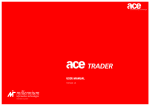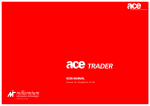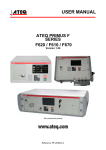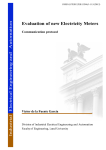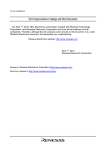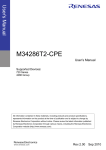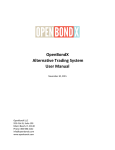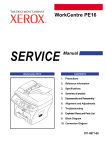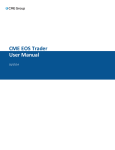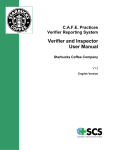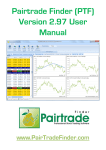Download pdf
Transcript
Contents Edited by Foxit PDF Editor Copyright (c) by Foxit Software Company, 2004 For Evaluation Only. Introduction 5 About Exchange™ 6 Using this Manual 7 Documentation Updates and Feedback 8 Index of Concepts Getting Started 9 Interface Digital User Manual (PDF) 10 Order Entry Window The Login Screen 11 Keyboard Shortcuts 34 Client Codes, Snap Quote Symbols 35 Concepts 36 37 38 40 Instrument Type, Underlying Instrument, Order Type, Side, Price, Size, Validity 41 Changing the Password 12 Sync, Own/Cli, Client Code, Client Name, Disclosed Size, Expiry Date/Time, Quick Lots 42 Editing a User Environment 13 Snap Quote 43 Basic Interface Operation Locking the Workstation 14 Order Book Window 16 44 Filters and Field Settings 45 Default Fields 46 Table Settings 18 Composite Fields 22 Market Depth Window 47 Gradient Color 23 My Trades Window 48 Save as Default 24 Filters Contract Selector Window 25 Market Watch Window Profiles 27 LastSeenProfile Workspaces Preferences Window 28 31 Order Entry Preferences 33 50 Market Watch Window Right-Click Menu 51 Default Fields 52 29 Message Log Window 30 Snap Quote Window General Preferences 49 Net Position Window Default Fields 53 54 55 56 Contents Time and Sales Window 57 The Ticker 58 Ticker Settings Contract Information Window Default Fields Contract List Window Default Fields Most Active Contracts window Default Most Active Contracts Fields Top Gainers and Losers window Default Fields 59 60 61 62 63 64 65 66 67 Manage Users Window 68 Margin Watch Window 69 Procedures 70 Order Entry Preferences 71 Submitting Orders 72 To Submit a Regular Order 73 To Submit a Good Till Time Order 74 To Submit a Good Till Date Order 75 To Submit a Stop Order 76 Amending an Order 77 Cancelling an Order 78 Edited by Foxit PDF Editor Copyright (c) by Foxit Software Company, 2004 For Evaluation Only. Mass Order Cancellation Appendices Document Change Control 79 82 83 Introduction Indian Commodity Exchange Trader User Manual About Exchange™ Edited by Foxit PDF Editor Copyright (c) by Foxit Software Company, 2004 For Evaluation Only. Introduction to Indian Commodity Exchange Trader The Indian Commodity Exchange Trader Front End provides a user-friendly interface for market participants to submit and manage their order interest, and to view market data such as order books, market statistics and time and sales information. It also contains features to help enhance the efficiencyoftheusersuchastheabilitytosaveprofilesandtocustomizethecontentandformatofwindows. The Indian Commodity Exchange Trader front-end offers different functionality depending on the type of user. The two types of users are identified as a Standard Trader and a Trading Administrator Trader roles . are specified in the Exchange Manager front-end when creating a user. This manual describes functionality applicable to both types of users. 6 Using this Manual by Foxit PDF Editor Indian Edited Commodity Exchange Trader User Manual Copyright (c) by Foxit Software Company, 2004 For Evaluation Only. This manual is divided into four sections: Getting Started This section deals with setting up, basic operation and customization of the Indian Commodity Exchange Trader Application. Concepts TheConceptssectiondefinesallconceptsusedwithintheIndian Commodity Exchange Trader Application and this manual. Concepts are displayed in this manual with a yellow underline like this . Descriptions for any concept highlighted in this manner may be found in the Concepts Section. Interface The Interface section is a detailed description of the Indian Commodity Exchange Trader Application interface. Procedures Thefinalsectionofthismanualcontainsdetailedstep-by-stepinstructionsforusingtheIndian Commodity Exchange Trader Application. 7 Documentation Updates and Feedback This User Manual is intended for use with the recommended version of the Indian Commodity Exchange Trader front-end. Updates to this manual will be made available with each Indian Commodity Exchange Trader release. For feedback, comments and suggestions please contact ICEX customer support at 8 [email protected] Getting Started Getting Started Digital User Manual (PDF) by Foxit PDF Editor Indian Edited Commodity Trader Copyright (c) by FoxitExchange Software Company, 2004 User Manual For Evaluation Only. This document is set for optimized reading using Adobe® Reader® version 8.0 or newer. Viewing the document using an alternative media reader could be possible. However some of the features used in this document might not be supported. Click to download the latest version of Adobe®Reader®. Navigating the Document using Adobe® Reader® The Page Navigation tool bar opens by default. To move through the document, do one of the following: • Click the Previous Page or Next Page on the tool bar. • Choose View Æ Go To Æ [Location]. Location choices are First Page, Previous Page, Next Page, Last Page, Previous View, or Next View. • Choose View Æ Go To Æ Page, and then type the page number in the Go To Page dialog box. • Press the Page Up and Page Down keys. Using Bookmarks Bookmarks provide a table of contents and represent the chapters and sections in a document. Bookmarks appear in the navigation panel. • Click the Bookmarks button, or choose View Æ Navigation Panels Æ Bookmarks. • To jump to a topic, click the bookmark. Click the plus (+) or minus (-) sign to expand or collapse the bookmark contents. Searching this Manual Current page Magnification number The Find option will allow you to search for a particular word or phrase within the document. • To Find, Select Ctrl + F or choose Edit Æ Find Once the search is completed, the relevant word/phrase will be highlighted within the document. If there is more than one instance of the search criteria within the document, the Find Previous / Find Previous Page View Next buttons will appear on the navigation tool bar and will Previous Page/ / Next Page View Next Page allow you to browse each instance of the search criteria. Search for a particular word/phrase Reference Links Certainsectionsofthedocumentrefertoanotherchapterorsectionfordetaileddescriptionofcertainfields.Thesereferencelinkscanbeidentifiedbyan underline like this. Clicking the Arrow on the bottom right hand corner of each page will allow the user to jump back to the Contents page. 10 Getting Started The Login Screen by Foxit PDF Editor Indian Edited Commodity Trader Copyright (c) by FoxitExchange Software Company, 2004 User Manual For Evaluation Only. Upon running the Indian Commodity Exchange Trader front-end, the user is first presented with the login screen. A user environment must be selected prior to login. 1. Click the Login Options button to expand the pane and display additional options. (The default view is shown on the left). 2. Click on Select System. 3. Select an environment from the list of available systems. To proceed with login: 4. Enter the Member ID. 5. Enter the User ID. 6. Enter the Password. 7. Click the Login button. The user will then be presented with the main application screen. Load Profile option 8. Checking the Load Profileoptionwillenabletheuser’slastseenprofiletoloadonlogin. Current front-end version 2 1 4 5 6 Systems list 3 8 7 11 Getting Started by Foxit PDF Editor Indian Edited Commodity Trader Copyright (c) by FoxitExchange Software Company, 2004 User Manual Changing the Password For Evaluation Only. The user’s current password can be changed using the following steps: Before login, 1. Enter your New Password. 2. Type your new password in the Confirm Password field. Login using the user-name and current password as shown here. The new password will be active from the next user login. 1 2 12 Getting Started Indian Commodity Exchange Trader User Manual Editing a User Environment 1. 2. 3. 4. 5. 6. 7. 8. 9. Select Edit Systems. Select a system from the Select System list. To Enter a new system, select < New Entry > from the Select System list. Ifconfiguringanewsystem,enteranameforthesystem. If required change the Description. If required edit the SReg Port. If required edit the MDMC SIDs. If required edit the FLB port. If required edit the FLB IP. Click the Edit button to save changes. 1 6 2 7 3 8 4 5 9 13 Getting Started Basic Interface Operation by Foxit PDF Editor Indian Edited Commodity Trader Copyright (c) by FoxitExchange Software Company, 2004 User Manual For Evaluation Only. This chapter deals with basic operation of the Indian Commodity Exchange Trader Application. Window Manipulation The Indian Commodity Exchange Trader Application is designed to be similar in operation to a standard Microsoft Windows® user interface and shares many common features, such as: Window Operations 1. The Minimize button - Clicking this button minimizes the selected window. 2. The Maximize button - Clicking this button maximizes the windowtofilltheentireworkspace. 3. The Close button - This button closes the current window. 4. Window re-sizing - Some windows may be re-sized by “grabbing” the edge of the window with the mouse pointer and dragging to the desired size. Any window that causes the mouse pointer to change to a double-headed arrow (as shown here ÙÚ ) can be re-sized. 5. Moving a window - Any window may be moved by clicking on the title bar and moving the window to its new location. 1 6 Window Controls and Field Behavior 6. Spin buttons - Clicking on a Spin button can increase or decrease the selected control by the default Order Quantity or Price Tick for the symbol. will display a list of all available values for 7. Drop-down list - Clicking on the arrow the selected control. You may then select from this list by clicking on the desired value. 14 7 5 2 3 Getting Started 8. Scroll Bars-Ascrollbarallowsyoutonavigatealistwhichistoolarge to fit in the display area. The user can scroll through the list by clicking and dragging the scroller or by clicking on the scroll buttons. 9. Tabs - Some windows such as the Market Depth window (shown right) uses Tabs to group controls by relevance. Tabs are also used to select symbols on windows with a Symbol Selection bar. 10. Columns - Some windows contain information displayed in tabular form. This information may be sorted in ascending order by clicking on a Column Header. Clicking a second time will sort the column in descending order. The third time reverts the column to its original status. An arrow symbol denotes the sort order as follows: • Red arrow - ascending order • Blue arrow - descending order 9 The selected Tab 10 8 8 15 Getting Started by Foxit PDF Editor Indian Edited Commodity Trader Copyright (c) by FoxitExchange Software Company, 2004 User Manual Locking the Workstation For Evaluation Only. The user has the option of locking/unlocking the workstation. 1. Select the Lock Workstation option under File on the menu bar. 2. The workstation will now be locked and the user will be presented with the Workstation is Locked prompt. 3. To unlock the workstation, enter the password - this is the same password used at login. 4. Click OK. 1 2 3 4 16 Getting Started Common Right-Click Options by Foxit PDF Editor Indian Edited Commodity Trader Copyright (c) by FoxitExchange Software Company, 2004 User Manual For Evaluation Only. The following right-click options appear on all windows in the Indian Commodity Exchange Trader application, apart from the Workspace Manager and Preferences windows. • Hide Title Bar • Float Window • Make Independent of Workspace • Attach to Current Workspace The following additional options may be available. • Shrink • Contract Selector • Enable/Disable Auto Scroll Toggles title bar visibility, allowing the window to be locked in place. Selecting this option will open the Contract Selector window, which allows users to add or remove Instruments. Enables/disables the Auto Scroll function. Selecting this option will allow the window to behave independently of the Trader Workstation. Allows the window to be visible independent of the selected workspace. Attaches the window to the currently selected workspace. 17 Getting Started Table Settings by Foxit PDF Editor Indian Edited Commodity Trader Copyright (c) by FoxitExchange Software Company, 2004 User Manual For Evaluation Only. Table Settings allows the user to change the appearance of a window (For example, customize the display fields, text colour and font) by changing the display properties of that window. (This feature is unavailable for the Order Entry, Snap Quote, Contract Information, Preferences, Workspace Manager, Top Gainers andLosersandMostActiveContractswindows.)Theusercanalsoselectthecolumns/fieldstobedisplayed,changetheappearanceofthecolumnsandthe information that will be displayed in them. Selecting the Table Settings option from the right-click menu of a window opens the Table Settings window. A sample Table Settings window is shown below. 18 Getting Started Indian Commodity Exchange Trader User Manual The Table Settingswindowconsistsofaleftpanelandarightpanel.Theleftpaneldisplaysmessagesandfieldsrelevanttotheselectedwindow.Fieldsthat are presently displayed on the window are in bold. Theright-sidepaneldisplaysfieldsthatarepresentlyshownonthewindow.AfieldcanbeeitherStandardorComposite.Acompositefieldisacombination ofseveralstandardfields.Eachfieldisidentifiedbya: • Field Name–Thiscontainsthenameofthefieldwhichtheuserselectsfromtheleftpanel.Thiscannotbeedited. • Column Name–Nameofthefielddisplayedonthewindow.ThismayormaynotbethesameastheField Name.Doubleclickacolumnnameofafieldto change it. • Type–SpecifiesifthefieldisStandard or Composite.Thisfieldisnoteditable. • Alignment–Specifiesfieldalignment.Theusercanchangethealignmentbyselectingthisoptionforafieldandselectingtherequiredalignmentfromthe list provided. The user can also change the alignment by selecting the alignment buttons. • Width – The width of the column in pixels. • Max Decimal – The maximum number of decimal places permitted for a value. Selected by means of a drop-down menu with integers from 0 to 9. • Min Decimal – The minimum number of decimal places permitted for a value. Selected by means of a dropdown menu with integers from 0 to 9. • Show Zero–Specifieswhetherthevalue0shouldbe displayedonafield.Theusercanchoosetohavethe relevantfieldleftblankwhenthefieldvalueiszero. Select TRUE/FALSE from the drop-down menu to specifyifthevalue0shouldbedisplayedorifthefield istobeleftblank.Thisoptionisonlyvalidforfields which have integer values. 19 Getting Started by Foxit PDF Editor Indian Edited Commodity Trader Copyright (c) by FoxitExchange Software Company, 2004 User Manual For Evaluation Only. To select a field for displaying on a window Toselectafield,double-clickonitintheleftpanel.Selectedfieldswillbedisplayedinthepanelontheright.Usingthispanel,theusercanchangethe propertiesjustdescribed.Double-clickafieldtochangeit. Show Header Checkbox – Will show/hide the headings of each column. To remove a field from a window 1. Selectthefieldtoberemovedinthepanelontheright. 2. Press the Deletekeyonthekeyboardordouble-clickthefield. To change the displayed font color of a field 1. Selectthefieldtochangethefontcolorfromtherightpanel. and select the required 2. Click the Font Color arrow button font color. To change the displayed background color of a field 1. Selectthefieldyouwishtomodifyfromtherightpanel. 2. Click the Selected Columns arrow button quired color. and select the re- To change the background color of the window Click the Background Color arrow button required color. and select the To change the font . This button will 1. Click the Font button display the name and size of the current font being used. 2. The font window will be displayed. You may change the Font, Font Style and Size. 3. Click the OK button. To change the selection color Click the Selection Color arrow button color. and select the required 20 Draw Grid Checkbox – Will show/hide gridlines around each cell in the table. Getting Started The Show Rect Selector Checkbox by Foxit PDF Editor Indian Edited Commodity Trader Copyright (c) by FoxitExchange Software Company, 2004 User Manual For Evaluation Only. Show Rect Selector Checkbox – Will show/hide a grey box adjacent to each row (shown below) in the table for easier selection 21 Getting Started Composite Fields Edited by Foxit PDF Editor Copyright (c) by Foxit Software Company, 2004 For Evaluation Only. Thefieldtypeidentifiesafieldasstandard or composite.Acompositefieldisacombinationofseveralstandardfields,createdbydraggingstandardfieldsonto the window as described below. To create a Composite Field Click the button on the Table Settings window. The Set Composite Field window (shown right) is displayed. 1. Enter a name for the column. 2. Ifacolumnnameisnotentered,thecompositefieldappears as the column name. 3. SelectafieldtoaddfromtheleftpaneloftheTable Settings window. 4. Drag and drop this field on to the Set Composite Field window. 5. To add text (characters, etc.) after a field, simply enter it into the Free Text box and click Add. 6. SelectanotherfieldtoaddfromtheleftpaneloftheTable Settings window. 7. Drag and drop this field on to the Set Composite Field window. 8. Repeat steps 4 – 7 until the required composite field is created. 9. Click OK. Thecompositefieldcreatedisdisplayedintherightpanelof the Table Settings window. To edit a Composite Field 1. Selectanexistingcompositefieldtoeditfromtherightpanelbyclickingonit,highlightingitsrow. 2. Click the button on the Table Settings window. The Set Composite Field window (shown right) isdisplayed.Thefieldmaythenbeedited. To remove a Composite Field 1. SelectthecompositefieldtoremovefromtherightpaneloftheTable Settings window. 2. Press the Deletekeyonthekeyboardordouble-clickthefield. 22 Getting Started by Foxit PDF Editor Indian Edited Commodity Trader Copyright (c) by FoxitExchange Software Company, 2004 User Manual Gradient Color For Evaluation Only. The user can create a linear gradient color for the table. To set a Gradient Color Example scenario: Set a two color gradient from green to red. 1. Check the Enable Gradient Color box. 2. Select TWO COLOR as the Gradient Type. 3. Select the Starting Color. 4. Select the Ending Color. 5. Select the Text Color. 6. Set the Amount of Color Change slider according to the number of steps to be shown in the gradient. 7. Set the No of Different Colors slider according to the number of colors to be shown in the gradient. 1 3 9 4 5 6 The Repeat Colors Option 8. Checking the Repeat Colors box will make the gradient repeat itself. The Preview Option The Preview pane will allow the user to preview color options for individual rows and panes. 9. Select a row in the preview pane. 10. Change the row color and the font color. 11. Use the Reset button to revert to the original settings. 10 2 7 11 8 23 Getting Started by Foxit PDF Editor Indian Edited Commodity Trader Copyright (c) by FoxitExchange Software Company, 2004 User Manual Save as Default For Evaluation Only. Oncetheuserhasfinalizedthetablesettingsforawindow,itcanbesavedasthedefaultsettingforthattypeofwindow.Thelayoutofanynewinstancesof this window type would follow the default settings. 1. Click on the window icon on 1 the title bar 2. Select the Save as default option 2 1 Deleting Default Configurations Theusercandeletethedefaultconfigurationsfor all windows using the following steps. 1. Click on Profile in the menu bar 2. Select the Delete User Default Config option 3. Click Yesontheconfirmationprompt 2 3 24 Getting Started Contract Selector Window by Foxit PDF Editor Indian Edited Commodity Trader Copyright (c) by FoxitExchange Software Company, 2004 User Manual For Evaluation Only. As the number of tradeable symbols is quite large, the Contract Selector is a quick means of locating required symbols. It can be invoked through the rightclick menus in the Order Entry, Order Book, My Trades, Market Depth, Time and Sales and Snap Quote windows. Alternatively, a hotkey for the Contract SelectorwindowcanbespecifiedintheUser Preferences window. 25 Getting Started by Foxit PDF Editor Indian Edited Commodity Trader Copyright (c) by FoxitExchange Software Company, 2004 User Manual For Evaluation Only. Applies filter criteria Removes all filters. Restricts the symbol list based on the criteria given (wild cards such as “?”, and “*” can be used). Filters by Underlying Instrument. Filters by Expiry Date. The following options are available for the selected symbol via the right-click menu: Open a new Order Entry window Open the Market Depth window Open the My Trades window The windows will be populated based on data for that instrument. 26 Getting Started Profiles by Foxit PDF Editor Indian Edited Commodity Trader Copyright (c) by FoxitExchange Software Company, 2004 User Manual For Evaluation Only. The Indian Commodity Exchange Trader application allows the user to configure the layout of the interface and save layouts for future use as profiles using Window Profiles Loading, saving and deleting profiles is achieved which can be accessed through the menu bar. The user is able to have multiple user profiles per user login. These profiles allow the user to create and save specific window layouts for later access. The saved layouts include the instruments selected for each window. Selecting either of the three options; Load Profile, Save Profile, Delete Profile, launches the relevant window for that function as shown here for the Save Profile function. Save Profile window Enter a name for the profile to be saved Click ‘Save’ to save current profile 27 Getting Started by Foxit PDF Editor Indian Edited Commodity Trader Copyright (c) by FoxitExchange Software Company, 2004 User Manual Last Seen Profile For Evaluation Only. Theuserhastheoptiontoautomaticallysavetheprofileonexit.Thiswillsavethelastseenprofile.AtthenextinstancetheuserlogsintotheTraderfrontend,thelastseenprofilewillload.Theuserthenhastheoptiontoloadanypreviouslysavedprofile. Toconfigurethelastseenprofile: Getting Started To open the Preferences window: 1. Click the Preferences button on the toolbar. 2. Select the Preferences option under Settings on the menu bar. 1. Select the General tab. 2. Check the Save profile on exit option. 3. Click Save & Close. 1 2 Note: In order for the last seen profile to load at the next login, the Load Profile option to has to be checked in the Login Screen. Please refer the chapter titled Login for further details. 3 28 Getting Started Workspaces by Foxit PDF Editor Indian Edited Commodity Trader Copyright (c) by FoxitExchange Software Company, 2004 User Manual For Evaluation Only. The Indian Commodity Exchange Trader front-end supports multiple workspaces. A workspace is an option to increase screen real-estate, by configuring the Trader application or workspaces, In each workspace, to consist of multiple pages each one of them containing various windows. the layout ofwindowscanbeconfigureddifferently.TheusercanconfigureworkspacesusingtheWorkspace Manager window. Getting Started To open the Workspace Manager: 1. Click the Workspace Manager button on the tool bar. 2. Select Settings > Workspace Manager on the menu bar 3. UsethehotkeydefinedinthePreferenceswindow To create a new workspace 1. 2. 3. 4. In the Workspace Manager window, enter a name for the New Workspace (<10 characters). Click Create. The new workspace will appear as a new button. To delete a workspace, simply select the workspace and click the button 1 2 3 To duplicate a workspace The user can copy the layout in one workspace to another workspace as shown below: 1. In the Workspace Manager window, select an existing workspace. 2. Select the source workspace (to clone from) 3. Click Duplicate. 2 29 3 1 4 Getting Started Preferences Window by Foxit PDF Editor Indian Edited Commodity Trader Copyright (c) by FoxitExchange Software Company, 2004 User Manual For Evaluation Only. The User Preferenceswindowisusedtofine-tunethefunctionalityofotherwindowsintheIndian Commodity Exchange Trader application. This window can also windows and window-specific functionality. Only one preference window can be be used to define hot keys for accessing opened and it is independent of workspaces. Getting Started Use one of the following methods: 1. Click the User Preferences Button (shown here) 2. Select Settings > Preferences 3. Use the hotkey defined in the Preferences window Preferences are grouped into the following sections: • General • Order Entry • Keyboard shortcuts • Client Codes • Snap Quote Symbols 30 Getting Started by Foxit PDF Editor Indian Edited Commodity Trader Copyright (c) by FoxitExchange Software Company, 2004 User Manual For Evaluation Only. General Preferences ThistabenablestheusertoconfiguregeneralpreferencesthataffectthebehavioroftheTraderapplication. UndertheGeneraltabtheusercanconfigurethefollowing; Application Allows the user to change the following general settings across all windows: • Disable application close button • Minimize to tray • Saveprofileonexit • Display connection strength • Display ticker • Hide title bar • Icons only in main tool bar • Global font Market Watch Allows the user to configure these aspects of the Market Watch window: • Market Up Color • Market Down Color Market Depth AllowstheusertoconfiguretheMarket Depthwindowbyspecifying; • Open with snap quote (enable / disable) • Number of price points Order Book AllowstheusertoconfiguretheOrder Bookwindowbyspecifying; • New records added to the Top (enable / disable) • Auto-scroll (enable / disable) • DefaultStatus(All/Cancelled/Filled/Open/Pfilled/Rejected) • Colors of Orders (Buy Pending / Sell Pending / Other) 31 Getting Started Snap Quote AllowstheusertoconfiguretheSnap Quotewindowbyspecifying; • Number of Rows • Number of Columns by Foxit PDF Editor Indian Edited Commodity Trader Copyright (c) by FoxitExchange Software Company, 2004 User Manual For Evaluation Only. My Trades Allowstheusertoconfigurethe My Trades windowbyspecifying; • Auto-scroll (enable / disable) • New rows added to the top (enable / disable) Most Active Contracts/Top gainers and losers Allowstheusertospecify; • Number of most active contracts • Number of top gainers or losers Note: The Auto Scroll option can also be enabled and disabled by right-clicking on individual windows and selecting the option from the displayed menu. 32 Getting Started Order Entry Preferences by Foxit PDF Editor Indian Edited Commodity Trader Copyright (c) by FoxitExchange Software Company, 2004 User Manual For Evaluation Only. This tab allows the user to change settings related to order entry Order Confirmation • New Order • Order Amendment • Market Order • Order Cancellation • ClientCodeModification Quick Lots • SetstheuserdefinedquantitiesforeachQuick Lots button Other • Default Order Quantity • Own/Client orders by default • Default Order Type • Buy form color • Sell form color • Close on Submission Alert Parameters Allows the user to specify parameters for the following: • Quantity Alert (in market lots) • Price Alert (percentage of LTP) • Value Alert (Quantity x Price) 33 Getting Started by Foxit PDF Editor Indian Edited Commodity Trader Copyright (c by (c) byFoxit FoxitExchange Software SoftwareCompany, Company, 2004 2004 User Manual For Evaluation Evaluanly. Only. Keyboard Shortcuts Thistaballowsuserstochangethedefaultshortcutkeyswhichallowthemtoaccessgeneralapplicationwindowsandperformcertainwindow-specific functions. To specify a hot key for a window or a functionality: 1. Selecttheclassificationfromthedrop-downselector. 2. Select the function. 3. Click in the Key column and press ‘Ctrl’ + <key> on the keyboard (eg: Ctrl+D). 4. Click the Save button. 5. Clicking the Restore Defaults button will reset all shortcut keys to the default values. 6. Select a function and click the Delete button to clear the Keyfield. General • Shortcutkeyscanbedefinedforopeningthemainwindowsoftheapplication. Application • Allowstheusertodefineshortcutkeysforbasicapplicationoperations. Active Window • Shortcutkeyscanbedefinedtoaccesstheattributesofthecurrentlyactivewindow. 1 2 3 6 Market Depth • AllowstheusertodefineshortcutkeysforMarket Depth window functions. Market Watch • AllowstheusertodefineshortcutkeysforMarket Watch window functions. New Order • AllowstheusertodefineshortcutkeysforNew Order window functions. Order Book • AllowstheusertodefineshortcutkeysforOrder Book window functions. 5 34 4 Getting Started by Foxit PDF Editor Indian Edited Commodity Trader Copyright (c) by FoxitExchange Software Company, 2004 User Manual For Evaluation Only. Client Codes, Snap Quote Symbols Client Codes 4 3 ThistaballowsuserstodefinefrequentlyusedClientCodesandmakethemappearinthe drop-down list on the Order Entry window. The Client Namefieldcanalsobeupdatedhere sothatthefieldisfilledwhentherelevantClientCodeisselected. To add a new Client Code: 1. Fill the Client CodefieldandentertheClient Name. 2. Click the Add button. To delete a Client Code: 3. Select the Client Code to be deleted 4. Click the Delete button. 6 1 2 5 7 9 8 Snap Quote Symbols This adds instruments to be displayed on the Snap Quote window. To add a symbol: 5. Click the Add Symbol button. 6. This will display the Contract Selector window. Select the required instrument from this window. For more information on the Contract Selector window, click here. To delete a symbol: 7. Select the symbol to be deleted by clicking on it 8. Click the Delete button 9 35 9. Click the Save button to save all changes. Concepts Concepts Index of Concepts Indian Commodity Exchange Trader User Manual Edited by Foxit PDF Editor Copyright (c) by Foxit Software Company, 2004 For Evaluation Only. This section lists and describes concepts used in the International Multi-Commodity Exchange Trader Application. Concept MBO (Market By Order) Description Publishes the following real-time data for each order: • • • • MBP (Market By Price) Displays the following real-time data for each price point: • • • • • TIF (Time In Force)/Validity Instrument Price Number of contracts (i.e. – quantity) Side Instrument Price Number of contracts (i.e. – quantity) Number of order (i.e. splits) Side Thetypesofvaliditieswhichcanbespecifiedforanorder.Theseare: Day - Day orders GTC - Good Till Cancel orders GTD - Good Till Date orders GTT - Good Till Time orders IOC - Immediate or Cancel orders Day (Day orders) Day orders expire at the end of trading on the day on which they are submitted. GTC (Good Till Cancel orders) GTC orders are valid until cancelled by the user. GTD (Good Till Date orders) GTDordersexpireattheendoftradingonthedayspecifiedbytheuser. GTT (Good Till Time orders) Theseordersexpireduringthetradingdayatatimespecifiedbytheuser. IOC (Immediate or Cancel orders) An order for which the maximum possible quantity will be filled on receipt, with the remainder expiring immediately. 37 Interface Note: Please bear in mind that any screen captures that you may view in this User Manual may display assumed Trader names, symbols, prices etc. Interface Order Entry Window by Foxit PDF Editor Indian Edited Commodity Exchange Trader User Manual Copyright (c) by Foxit Software Company, 2004 For Evaluation Only. The Order Entry window is the primary order entry window for all users of the Indian Commodity Exchange Trader workstation. Itconsistsoftwomainviews;i.e.theSummaryView(shownbelow)andtheAdvancedOptionsView.Allbasicorderentryoptionswillbeavailableinthe Summary View. Before an instrument is selected, the Order Entry windowdefaultstoagreywindowwithinactivefields.Onceaninstrumenthasbeenselected,thecontents ofthefieldscanbeeditedandthewindowwillchangecolourbasedontheSide selected. Getting Started Use one of the following methods: 1. Click the New Order button (shown here) 2. Select Transactions > Order Entry on the menu bar 3. UsethehotkeydefinedinthePreferenceswindow 40 Note: • Double-clicking on any of the following in the Market Watch window will populate the window based on the price source clicked: (a) Best bid price (b) Best bid size (c) Best offer price (d) Best offer size (e) Any other column in the window (which will associate the window with the last traded price) • Double-clicking on any of the following on the Snap Quotes window will populate the window based on the price source clicked: (a) Best bid price (b) Best offer price (c) Last trade price Interface Instrument Type, Underlying Instrument, Order Type, Side, Price, Size, Validity The user may select the required Underlying Instrument from this drop-down list. After selecting the instrument (and Expiry Date, if applicable), press the Enter key to accept and open a new tab. Other fields will be inactive and cannot be edited until an instrument has been selected. Expiry Date of the instrument The Side selection drop-down contains the values Buy and Sell. Clicking the drop-down at any time will enable the user to switch between modes. Depending on the side selected, the window will change color. The default color is blue for BUY and red for SELL. For more details refer the section on Order Entry Preferences in the chapter on User Preferences. The user may select the Instrument type from this drop-down list. The Order Type drop-down list contains the following values: • Limit • Market • Stop • Stop limit If the value Market or Stop is selected, the price field is disabled. This control allows the user to specify the Order Size by typing the quantity directly into the text box or by using the spin buttons. This drop-down menu allows the user to specify the Validity (TIF) of an order. Use the Price Entry control to enter or modify the price for a new order by typing the price directly into the Price Entry textbox or by using the Price Entry spin buttons. 41 Available Options for Validity 1. Day (Day Orders) - Day orders will expire at the end of trading on the day they are submitted 2. Good Till Cancel (GTC) - GTC orders will be valid until cancelled by you. 3. Good Till Date (GTD) - GTD orders will expire at the end of trading on the day specified by you 4. Good Till Time (GTT) - GTT orders will expire during the trading day at a time specified by you 5. Immediate or Cancel (IOC) - An order that will be filled as much as possible on receipt with the remainder immediately expiring Interface Sync, Own/Cli, Client Code, Client Name, Disclosed Size, Expiry Date/Time, Quick Lots Synchronizes the window with a price source. For example, selecting this check box while the Buy side is selected synchronizes the window with the Best Offer price for that symbol. The Client Name appears automatically if the relevant Client Code has been entered in the Client Codes section of the Preferences window. This field cannot be edited. The Client Code can be specified here, either by selecting the pre-defined Client Code from the drop-down list (see User Preferences - Client Codes), or by entering it here. The contents of this field must be alphanumeric. Identifies the ‘Owner’ / ‘Client’ of the order – when submitting orders on behalf of traders within a group (node) or within the firm. Quick Lots are used to facilitate predefined lots selected for order entry. The lots assigned to each button can be configured by the user (see Order Entry Preferences). The row of buttons simply replaces the size/visible size entities for the order. To update the fields, select the field and then click the relevant Quick Lots button. 42 The Disclosed Size indicates the quantity to be visible out of the total order quantity. The Expiry Date/Time field will only be enabled when the Validity (TIF) selected is GTD or GTT. The format will be DD:MM:YY for GTD and HH:MM:SS for GTT. This option enables the user to view the recent orders placed that have not reached the Exchange, although they have left the Trader front-end. The orders displayed are not limited to the selected instrument. Interface by Foxit PDF Editor Indian Edited Commodity Exchange Trader User Manual Copyright (c) by Foxit Software Company, 2004 Snap Quote For Evaluation Only. A snap quote can be invoked within the order entry form by clicking the button. The snap quote displays information relating to the selected instrument. This will include the following information: • Best Buy Price • Best Buy Movement • Best Buy Quantity • Net Direction • Best Sell Quantity • Best Sell Price • Best Sell Movement • Last Traded Price • Last Traded Quantity 43 Interface Order Book Window Indian Commodity Exchange Trader User Manual The Order Book window allows the user to track the status of his/her orders and manage orders and executions. Order information related to all orders submittedbythetraderaredisplayedbydefault.Inaddition,ausercanselectaspecificinstrumentinordertoviewinformationforthatinstrument.The filteroptionsavailableinthiswindowhelptheusertosortandviewonlytherequiredinformation.Thedisplayoforderinformationcanbeconfigured. Getting Started Use one of the following methods: 1. Click the Order Book button (shown here) 2. Select Transactions > Order Book on the menu bar 3. UsethehotkeydefinedinthePreferenceswindow 44 Interface by Foxit PDF Editor Indian Edited Commodity Exchange Trader User Manual Copyright (c) by Foxit Software Company, 2004 For Evaluation Only. Filters and Field Settings The user has the option of filtering the orders shown in the Order Book. If an instrument is not selected, filters are applied to all Instruments. Instrument type (defaults to Future) Specifying these allows the user to filter orders by symbol. Select the appropriate details and press the Enter key to open a new tab for the selected instrument. Underlying Instrument Click the Apply button to filter orders by selected criteria. Instrument Expiry Date The Side filter allows the user to view the Order Book for either buy or sell orders. Selecting the All option will show orders for both sides. The Clear button removes all filters apart from the Symbol/Instrument filter. Cancels the selected order Modifies the order Fields may be rearranged by dragging and dropping their column headers to a new position. Fields may also be added or removed using the Table Settings window which can be accessed via the right-click menu. The displayed orders can also be sorted according to any attribute by clicking on the column header. Filters by the ID of the trader who entered the order Filters by Client Code Filters by Order ID 45 Using the Status filter, orders can be filtered according to the following criteria: All – Retrieves all orders for the day of the selected instrument Pending - Retrieves the Open (including pending, partially filled and modified) orders of the selected instrument Executed - Retrieves the Filled orders of the selected instrument Canceled - Retrieves the Cancelled and Expired orders of the selected instrument (includes Expired orders) Rejected - Retrieves the Rejected orders of the selected instrument Interface by Foxit PDF Editor Indian Edited Commodity Exchange Trader User Manual Copyright (c) by Foxit Software Company, 2004 For Evaluation Only. Default Fields Shows whether the order is a Buy or Sell order. The current state of the order submitted. The status can be one of the following: Filled, PFill, Open, Rejected, Cancelled and Expired. The portion of the order that has not yet been executed. The total quantity that has met with execution. (Total Qty - Pending Qty) 46 The Client Code for which the order was placed Shows the date & time the order was received by the backend system (includes seconds) – Displayed as ‘Time and Date” HH:MM:SS – DD/MM/ YY (date format as per user settings). The Order Type will be one of the following: Market, Limit, Stop, or Stop Limit. Any available reason for the current state of the order. Interface Market Depth Window by Foxit PDF Editor Indian Edited Commodity Exchange Trader User Manual Copyright (c) by Foxit Software Company, 2004 For Evaluation Only. This window enables the user to view the book depth of an instrument. The Trader Configuration ManagerwillpermitanyfieldtobeaddedtotheMarket DepthdefinitionsoitcanbeselectedfortheMarket Depth window. Market Depth can be either Spatial or Multicast. Using Spatial Market Depth, the user has the option of viewing orders according to MBO (Market By Order) or MBP (Market By Price). Specifying these allows the user to filter orders by symbol. Select the appropriate details and press the Enter key to open a new tab for the selected instrument. Instrument type Underlying Instrument Getting Started Use one of the following methods: 1. Click the Market Depth window button (shown here) 2. Select Market > Market Depth on the menu bar 3. UsethehotkeydefinedinthePreferenceswindow Instrument Expiry Date The dashboard displays a summarized view of the Market Watch window statistics. Note: Multiple Market Depth windows can be opened depending on user requirements. These windows will behave independently of each other. 47 Interface My Trades Window by Foxit PDF Editor Indian Edited Commodity Exchange Trader User Manual Copyright (c) by Foxit Software Company, 2004 For Evaluation Only. This window will enable the user to view trades affected by the orders placed by him and to modify the Client Code if needed. For users with Trading Administrator status, this will show all trades for the member. Getting Started Use one of the following methods: 1. Click the My Trades button (shown here) 2. Select Transactions > My Trades on the menu bar 3. UsethehotkeydefinedinthePreferenceswindow 48 Interface by Foxit PDF Editor Indian Edited Commodity Exchange Trader User Manual Copyright (c) by Foxit Software Company, 2004 For Evaluation Only. Filters Symbol - The available underlying instruments if the Instrument Type is Future. The available expiry dates for the selected underlying instrument. This field is disabled if the instrument type is not future. Filters by Order ID - the reference attached to the order that caused the trade. To filter by status, the following options are available: All - Retrieves all trades for the day of the selected instrument. Modified - Retrieves trades for the selected instrument which have been modified. Instrument Type Filters by Side of the traded order Buy/Sell Filters by the Client Code assigned to the client for the firm. Filters by the Trade ID assigned to the trade. Filters by Trader ID Allows the user to amend Client Codes if required. 49 Applies filters Clears all filters Interface Market Watch Window by Foxit PDF Editor Indian Edited Commodity Exchange Trader User Manual Copyright (c) by Foxit Software Company, 2004 For Evaluation Only. The Market Watch window displays market information for selected instruments. It allows the creation of multiple portfolios of instruments. Upon loading aportfolio,theinstrumentslistedwillbesortedaccordingtothesequencedefinedintheportfolio. Getting Started Use one of the following methods: 1. Click the Market Watch button (shown here) 2. Select Market > Market Watch on the menu bar 3. UsethehotkeydefinedinthePreferenceswindow Allows users to jump to the selected instrument in the All tab, or select instruments to be viewed when a new tab is open. Instrument type Underlying Instrument The user can select the portfolio to be loaded from the drop-down selector Instrument Expiry Date 50 Interface by Foxit PDF Editor Indian Edited Commodity Exchange Trader User Manual Copyright (c) by Foxit Software Company, 2004 Market Watch Window Right-Click Menu For Evaluation Only. To create a new portfolio, select the Add New Tab option from the right-click menu and add the required instruments to this tab by selecting them from the drop-down boxes or by right-clicking and selecting the Contract Selector option from the right-click menu. After all required instruments have been selected, choose the Save As Portfolio option on the right-click menu. The Order Book, Snap Quote, My Trades, Market Depth and Net Position windows for an underlying instrument can be invoked by selecting the desired window from the right-click menu in the Market Watch window. Opens Net Position window for selected symbol Removes selected symbol from tab Opens the Buy/ Sell side of the Order Entry window for the selected instrument. Saves changes to Portfolio Opens a new tab. Hides the titlebar, locking the window in place. Opens the Contract Selector window for the selected symbol Removes all symbols from the active tab S a v e s instruments in active tab as Portfolio. Saves displayed data in a text file. Changes Portfolio name Deletes Portfolio Opens the Order Book/ Snap Quote/ Market Depth or My Trades window for the selected instrument. Resizes columns to fit content. Opens the Table Settings window for Market Watch. 51 Interface Default Fields Underlying instrument for futures and the symbol name for any other instrument type Expiry date of the relevant instrument. Value at the best price point on the Buy side. Value at the best price point on the offer side. Value of the last trade. The price quote parameter of the instrument Cumulative quantity at the best Buy price Cumulative executed quantity Cumulative quantity at the best Sell price The value of the contract for the day. (The sum of traded qty * price of each trade for the instrument for the day * multiplier) The open interest in the market Highest trade price of the contract since its inception The first trade price of the instrument for the day Lowest trade price of the contract since its inception The last traded price of the instrument for the day Percentage change of the contract’s Last Traded Price and Previous Day’s Close Previous day’s closing price 52 The volume average price Number of trades performed weighted Interface Message Log Window Indian Commodity Exchange Trader User Manual Markets require the ability to disseminate information to trading participants. The Message Log window contains all the messages that are communicated to the trader workstation from the exchange. These are: 1. Market messages 2. Orderconfirmations(includingneworder,cancelandmodifyconfirmations) 3. Tradeconfirmations(includingtrademodifications) 4. System messages 5. Surveillance messages 6. Announcements (News and targeted messages) Getting Started Use one of the following methods: 1. Click the Message Log Button (shown here) 2. Select Market > Message Log on the menu bar 3. UsethehotkeydefinedinthePreferenceswindow Displays the message type Recipient of message Message subject The message containing information on the activity Number of messages 53 The time the message was sent to/from the Trader front-end from/to the exchange Sender of message Interface Snap Quote Window by Foxit PDF Editor Indian Edited Commodity Exchange Trader User Manual Copyright (c) by Foxit Software Company, 2004 For Evaluation Only. The Snap Quotewindowdisplaysmarketinformationforaninstrument.Itdisplaysacollectionoffieldsthatshowsmarketdataforaparticularinstrument. ItallowstheusertofocusonselectedinstrumentsdefinedintheSnap Quote Symbols preferences window. Multiple snap quotes will be arranged in a matrix formbasedonthenumberofrowsandcolumnsdefinedbytheuserinthePreferences window. In addition, if the user wishes to change the instrument assigned to a particular box, this can be done by selecting the instrument using the Contract Selector. Getting Started Use one of the following methods: 1. Click the Snap Quote button (shown here) 2. Select Market > Snap Quote on the menu bar 3. UsethehotkeydefinedinthePreferenceswindow Instrument Name Best Bid Net Direction Best Offer Bid Movement Indicator Offer Movement Indicator Offer Movement Bid Movement Last traded price Last traded quantity 54 Interface Net Position Window by Foxit PDF Editor Indian Edited Commodity Exchange Trader User Manual Copyright (c) by Foxit Software Company, 2004 For Evaluation Only. The Net Position window is used to view the trader’s net position and his client’s net position details in a common window. Trading Administrators will be abletoviewthenetpositionsforallclientsofthefirm. TheNetPositionwindowdefaultstoablankscreenbutispopulatedwiththerelevantdataonselectionoffiltercriteria. To view information for a particular symbol, select the instrument from the drop-down lists and click the Query button. For details on a client’s net position, type the relevant Client Code in the box and click Query. Getting Started Filter by symbol Use one of the following methods: 1. Click the Net Position button (shown here) 2. Select Transactions > Net Position on the menu bar 3. UsethehotkeydefinedinthePreferenceswindow Firm ID Instrument type Underlying Instrument Expiry Date 55 Filters by Client Code Applies filter criteria Clears all filters Interface by Foxit PDF Editor Indian Edited Commodity Exchange Trader User Manual Copyright (c) by Foxit Software Company, 2004 Default Fields For Evaluation Only. The code which the client is registered under, used by the trader to identify individual clients. Average Price of Total Buy Quantity Quantity bought Quantity sold Average Price of Total Sell Quantity The value of the position Total quantity bought – Total quantity sold As calculated by the risk system Position Value divided by Net Quantity Totals applicable to current filter criteria 56 L a s t t r a d e d price of the contract M T M Position Value Interface Time and Sales Window by Foxit PDF Editor Indian Edited Commodity Exchange Trader User Manual Copyright (c) by Foxit Software Company, 2004 For Evaluation Only. The Time and Sales window allows the user to view all trades that took place in the exchange for any selected instrument, irrespective of which trader initiated them. Getting Started Use one of the following methods: 1. Click the Time and Sales Button (shown here) 2. Select Transactions > Time and Sales on the menu bar 3. UsethehotkeydefinedinthePreferenceswindow Filters orders by symbol. Select the required details and press the Enter key to open a new tab for the selected instrument. Instrument type Underlying Instrument Instrument Expiry Date The Price tick established after the trade Time of the transaction including seconds (hh:mm:ss) Traded price The order quantity 57 Underlying instrument for futures and the symbol name for any other instrument type Interface The Ticker by Foxit PDF Editor Indian Edited Commodity Exchange Trader User Manual Copyright (c) by Foxit Software Company, 2004 For Evaluation Only. The Ticker bar provides real time last sale information of instruments traded on the exchange. The user has to have the Display Ticker option enabled in the Preferences window >General Tab in order for the Ticker bar to be displayed in the workspace. The ticker will display the following information per trade: • Name of the instrument that the trade took place for • Whether the trade tick direction is up or down (indicated by an arrow) • Quantity and Price of the trade • Net change between this trade and the previous trade The trade information will scroll from left to right. Instrument filter. By default, the ticker bar will subscribe to all the preferred instruments. The font colour will also reflect the price tick of the trade; Red – Minus or zero minus, Green – Plus or Zero plus The Ticker Speed can be set via the right-click menu. The Ticker Speed menu will contain the following pre-set options: • Fast • Medium • Slow • Natural 58 Interface by Foxit PDF Editor Indian Edited Commodity Exchange Trader User Manual Copyright (c) by Foxit Software Company, 2004 Ticker Settings For Evaluation Only. This window allows the user to edit the basic display settings for the ticker. Select the fields to be displayed in the ticker Define ticker colours 59 Interface Contract Information Window by Foxit PDF Editor Indian Edited Commodity Exchange Trader User Manual Copyright (c) by Foxit Software Company, 2004 For Evaluation Only. This window provides the means where a trader may view all the information relating to a contract selected by him. Getting Started Use one of the following methods: 1. Click the Contract Information button (shown here) 2. Select Contract > Contract Information from the menu bar 3. UsethehotkeydefinedinthePreferenceswindow 60 Interface by Foxit PDF Editor Indian Edited Commodity Exchange Trader User Manual Copyright (c) by Foxit Software Company, 2004 Default Fields Symbol field - displays the underlying instruments available in the system when the instrument type is future. Else, displays all available instruments for the selected instrument type. For Evaluation Only. Displays expiry dates available in the system for the chosen underlying instrument. Type of instrument; future or strategy Will be displayed as “Ex “ followed by The Delivery Base of the instrument (eg: Ex Mumbai). The underlyer of the instrument The expiry date of the instrument The trading lot of the instrument, followed by the trading unit of the instrument (eg: 10 KG) The tick defined as the first entry in the tick structure of the instrument The quantity against which prices are quoted, followed by the trading unit of the instrument. The additional margin defined for the instrument The initial margin defined for the instrument Maximum Order Size Daily Price range defined for the instrument 61 Interface Contract List Window by Foxit PDF Editor Indian Edited Commodity Exchange Trader User Manual Copyright (c) by Foxit Software Company, 2004 For Evaluation Only. The Contract List window contains the same details found in the Contract Information window, but for all the instruments at the same time. This allows a user to carry out comparisons across instruments with reference to instrument-related details. Getting Started Use one of the following methods: 1. Click the Contract List button (shown here) 2. Select Contract > Contract List from the menu bar 3. UsethehotkeydefinedinthePreferenceswindow 62 Interface Indian Commodity Exchange Trader User Manual Default Fields The underlying of the instrument The instrument ID Displays the expiry date of the relevant instrument Buy side (long) margin for the instrument Sell side (short) margin for the instrument The initial m a r g i n defined for the instrument The first trading date of the instrument Displays “Ex” followed by the Delivery Base of the instrument (e.g.: Ex Mumbai). Special margin for regulatory purposes The last t r a d i n g date of the instrument The additional margin defined for the instrument The quantity against which prices are quoted, followed by the trading unit of the instrument The trading lot of the instrument, followed by the trading unit of the instrument 63 Daily Price Range for the instrument – computed based on the previous day’s closing price and the price band values for the instrument. Shown in the format XXX.XX – YYY.YY Life-time price banding applicable to that instrument Interface Most Active Contracts window Indian Commodity Exchange Trader User Manual ThiswindowwilldisplaythetopcontractsintermsofValue.ThenumberofcontractswillbelimitedtothenumberspecifiedinthePreferenceswindow. Getting Started Use one of the following methods: 1. Click the Most Active Contracts button (shown here) 2. Select Contract > Most Active Contracts from the menu bar 3. Select Market > Most Active Contracts from the menu bar 4. UsethehotkeydefinedintheUserPreferenceswindow 64 Interface Indian Commodity Exchange Trader User Manual Default Most Active Contracts Fields Captures the underlying symbol for futures and the instrument name for instrument types other than futures. Type of Instrument Displays the expiry dates of the future contracts for the stated underlying symbol. Will not hold any values if the Instrument type is not future Cumulative executed quantity 65 Value of the last trade The value for the day Interface Top Gainers and Losers window Indian Commodity Exchange Trader User Manual Thiswindowwilldisplaythetopcontractsintermsofpercentagechangefromclosing.Thenumberofcontractswillbelimitedtothenumberspecifiedin the Preferences window. The window will update the gainers and losers automatically as trading takes place. Getting Started Use one of the following methods: 1. Click the Top Gainers and Losers button (shown here) 2. Select Contract > Top Gainers and Losers from the menu bar 3. Select Market > Top Gainers and Losers from the menu bar 4. UsethehotkeydefinedinthePreferenceswindow 66 Interface by Foxit PDF Editor Indian Edited Commodity Exchange Trader User Manual Copyright (c) by Foxit Software Company, 2004 Default Fields For Evaluation Only. The percentage change from closing The underlying symbol for futures Displays the expiry dates of the future contracts of the stated underlying symbol. Will not hold any values if the Instrument type is not future The previous closing price 67 day’s Value of the last trade Interface Manage Users Window Indian Commodity Exchange Trader User Manual The Manage Users section consists of windows for managing users and a section for viewing user information and attaching contract baskets to users. Standard Traders will be restricted to seeing only their entry, and cannot access to the administrative functions. TradingAdministrativeuserswillseealltradersundertheirfirmandbeabletocarryoutadministrativefunctions Getting Started Use one of the following methods: 1. Click the Manage Users button (shown here) 2. Select Control and Surveillance > Manage Users from the menu bar 3. UsethehotkeydefinedinthePreferenceswindow For a Standard Trader, the administrative functions will be disabled A Trading Administrator will be able to view all trades under their firm. 68 Interface Margin Watch Window by Foxit PDF Editor Indian Edited Commodity Exchange Trader User Manual Copyright (c) by Foxit Software Company, 2004 For Evaluation Only. ThiswindowisonlyaccessibletoTradingAdministrators.TheTradingAdministrationuserwillbeabletoseethedifferentmarginvaluesforhisfirmusing this window. Getting Started Use one of the following methods: 1. Click the Margin Watch button (shown here) 2. UsethehotkeydefinedinthePreferenceswindow Margin Limit Spread Benefit Initial Margin Long Margin Delivery Margin Short Margin Margin Utilized % Regulatory Margin Margin Utilized 69 Total Margin Liability MTM Limit MTM Loss MTM % Additional Margin ML % Procedures Procedures by Foxit PDF Editor Indian Edited Commodity Exchange Trader User Manual Copyright (c) by Foxit Software Company, 2004 For Evaluation Only. Order Entry Preferences The user can submit orders via the Order Entrywindow.Thefront-endusesvaluesspecifiedbytheuserinthePreferences window to populate the Order Entry window. 1. Open the Preferences window as shown here. 2. Select the Order Entry tab in the Preferences window. 3. Select the Order Confirmation options - this feature allows the user to chose whether the system initiates a confirmation prompt at the time of executing the following procedures: • Submitting orders • Amending orders • Submitting a Market Order • Order Cancellation • ClientCodeModification 4. Set the lot sizes for Quick Lots. 5. Specifyotherdefaultvaluesforfields. 6. Click Save. 2 4 3 5 6 71 Submitting Orders The following chapter describes in detail the procedure followed to submit the following types of orders: • • • • Submitting a Regular Order Submitting a Good Till Time Order Submitting a Good Till Date Order Submitting a Stop Order Procedures To Submit a Regular Order Getting Started Use one of the following methods: 1. Click the New Order button (shown here) 2. Select Transactions > Order Entry on the menu bar 3. UsethehotkeydefinedinthePreferenceswindow 1. 2. 3. 4. 5. 6. 7. 8. Select the required Instrument Type If Instrument Type is Future: Select the appropriate Underlying Instrument and Expiry Date Select Side: Buy or Sell Select Limit as the Order Type. Enter a value in the Pricefield. Enter a value in the Sizefield. Specify the Validity as DAY. Click the Buy/Sell button to submit the order. Toreceiveaconfirmationpromptwhensubmittingorders,pleasereferthechaptertitledOrder Entry Preferences. 2 1 4 3 5 6 7 8 73 Procedures To Submit a Good Till Time Order 1. 2. 3. 4. 5. 6. 7. 8. 9. Open the New Order window as shown here. Select the Instrument Type If Instrument Type is Future: Select the Underlying Instrument and Expiry Date Select Side: Buy/Sell Select GTT (Good till Time) as the Validity. Enter the Expiry Time. Select an Order Type. If the selected order type is a Stop or Stop Limit order, specify a Trigger Price. Click the Buy/Sell button to submit the order. Toreceiveaconfirmationpromptwhensubmittingorders,pleasereferthechaptertitledOrder Entry Preferences. 3 2 7 4 5 8 6 9 74 Procedures To Submit a Good Till Date Order 1. 2. 3. 4. 5. 6. 7. 8. 9. Open the New Order window as shown here. Select the Instrument Type If Instrument Type is Future: Select the Underlying Instrument and Expiry Date Select Side: Buy/Sell Select GTD (Good till Date) as the Validity. Enter the Expiry Time. Select an Order Type. If the selected order type is a Stop or Stop Limit order, specify a Trigger Price. Click the Buy/Sell button to submit the order. Toreceiveaconfirmationpromptwhensubmittingorders,pleasereferthechaptertitledOrder Entry Preferences. 3 2 4 7 5 8 6 9 75 Procedures To Submit a Stop Order 1. 2. 3. 4. 5. 6. 7. 8. 9. Open the New Order window as shown here. Select the Instrument Type If Instrument Type is Future: Select the Underlying Instrument and Expiry Date. Select Side: Buy/Sell Select Day as the Validity. Select Stop Limit or Stop as the Order Type. Enter a value in the Pricefield. Specify a Trigger Price. Click the Buy/Sell button to submit the order. Toreceiveaconfirmationpromptwhensubmittingorders,pleasereferthechaptertitledOrder Entry Preferences. 3 2 6 4 5 7 8 9 76 Procedures Amending an Order by Foxit PDF Editor Indian Edited Commodity Exchange Trader User Manual Copyright (c) by Foxit Software Company, 2004 For Evaluation Only. Getting Started Use one of the following methods: 1. Click the Order Book button (shown here) 2. Select Transactions > Order Book on the menu bar 3. UsethehotkeydefinedinthePreferenceswindow 1. Right-click on the order to be amended in the Order Book and select the Amend Order option. 2. The Order Entry window will be displayed for the particular order. 3. Make the required changes and click the Buy/Sell button. Toreceiveaconfirmationpromptwhenamendingorders,pleasereferthechapter titled Order Entry Preferences. 1 2 3 77 Note: Orders can also be amended through the Order Book in the same manner. Procedures Cancelling an Order by Foxit PDF Editor Indian Edited Commodity Exchange Trader User Manual Copyright (c) by Foxit Software Company, 2004 For Evaluation Only. Getting Started Use one of the following methods: 1. Click the Order Book button (shown here) 2. Select Transactions > Order Book on the menu bar 3. UsethehotkeydefinedinthePreferenceswindow 1. Right-click on the order to be cancelled in the Order Book. 2. Select the Cancel Order option from the right-click menu. 3. The Order Status of that order will change to Cancelled. Toreceiveaconfirmationpromptwhencancellingorders,pleasereferthe chapter titled Order Entry Preferences. 1 2 3 Note: Orders can also be cancelled through the Order Book in the same manner. 78 Procedures by Foxit PDF Editor Indian Edited Commodity Exchange Trader User Manual Copyright (c) by Foxit Software Company, 2004 Mass Order Cancellation For Evaluation Only. Getting Started Use one of the following methods: 1. Click the Order Book button (shown here) 2. Select Transactions > Order Book on the menu bar 3. UsethehotkeydefinedinthePreferenceswindow 1. Right-click on any order in the Order Book. 2. Select the Cancel All option. In Trader view, the sub-menu will display the following mass cancellation options: • Owner • Instrument In Trader Admin view, the following additional options are displayed: • Client • Trader • Member 3. Select the required option. 4. All orders under the selection will be cancelled. 2 To receive a confirmation prompt when cancelling orders, please refer the chapter titled Order Entry Preferences. 1 79 3 Procedures Additional Functionality by Foxit PDF Editor Indian Edited Commodity Exchange Trader User Manual Copyright (c) by Foxit Software Company, 2004 For Evaluation Only. Save to a Text File Thisoptionallowstheusertosavethecontentsofawindowtoatextfile.Thisfeatureisavailableforthefollowingwindows: • Order Book • My Trades • Market Watch • Time and Sales • Manage Users 1. Right-clickonafieldandselecttheSave as a text file option. 2. In the Save As window, specify the File name and location and click Save. 3. The progress bar will indicate the status. Click OK oncefinalized. 2 1 3 80 Procedures by Foxit PDF Editor Indian Edited Commodity Exchange Trader User Manual Copyright (c) by Foxit Software Company, 2004 For Evaluation Only. View the Order History This option allows the user to view the order history for a trade via a sub-window, which displays the history sorted based on time of the execution report. 1. Right-click on an order and select the Order History option. 2. The Order History window will be displayed for that particular order. 1 2 81
















































































